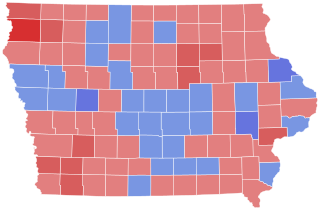
The 1968 United States Senate elections were elections for the United States Senate. Held on November 5, the 34 seats of Class 3 were contested in regular elections. They coincided with the presidential election of the same year. The Republicans picked up five net seats in the Senate. This saw Republicans win a Senate seat in Florida for the first time since Reconstruction.

Otha Donner Wearin was an American writer and politician. Elected as the youngest member of President Franklin D. Roosevelt's first "New Deal" Congress, his political career stalled in 1938 when he gave up his seat in the United States House of Representatives at Roosevelt's urging to run for a U.S. Senate seat held by another Democrat, Guy Gillette, but primary voters rallied behind Gillette. He became a prolific writer, which led to his election to the Cowboy Hall of Fame.

Clyde LaVerne Herring, an American Democratic politician who served as the 26th governor of Iowa, and then one of its U.S. senators, during the last part of the Great Depression and the first part of World War II.

Guy Mark Gillette was an American politician serving as a Democratic U.S. Representative and Senator from Iowa. In the U.S. Senate, Gillette was elected, re-elected, defeated, elected again, and defeated again.

George Allison Wilson was an American politician and lawyer. He was a United States Senator and 28th Governor of Iowa.
The Iowa Democratic Party (IDP) is the affiliate of the Democratic Party in the U.S. state of Iowa.
The politics of Colorado, United States, are that of a blue state. Once considered a swing state that used to be Republican-leaning, Colorado has been trending Democratic since the early part of the 21st century due to changing demographics and a rising number of the large unaffiliated bloc of voters leaning Democratic. The growing shift of the state's Republican Party towards social and religious conservatism along with shifting further to the right has also been cited as reasons for the changing voting patterns of Colorado.

The Ohio general elections, 2010 were held on November 2, 2010 throughout Ohio. Primary elections took place on May 4, 2010.

The 1890–91 United States Senate elections were held on various dates in various states. As these U.S. Senate elections were prior to the ratification of the Seventeenth Amendment in 1913, senators were chosen by state legislatures. Senators were elected over a wide range of time throughout 1890 and 1891, and a seat may have been filled months late or remained vacant due to legislative deadlock. In these elections, terms were up for the senators in Class 3.

The 1938 United States Senate election in Iowa took place on November 8, 1938. Incumbent Democratic Senator Guy M. Gillette, who won a special election to complete the unexpired term of Richard Louis Murphy, won a full term in office by defeating Republican former Senator Lester J. Dickinson. Gillette and Dickinson had briefly served together in the final months of 1936.

The 1948 United States Senate election in Iowa took place on November 2, 1948. Incumbent Republican Senator George A. Wilson ran for re-election to a second term but was defeated by Democratic former Senator Guy Gillette.

The 1956 United States Senate election in Iowa took place on November 6, 1956. Incumbent Republican Senator Bourke B. Hickenlooper was re-elected to a third term in office over Democrat Rudolph M. Evans.

The 1950 United States Senate election in Iowa took place on November 7, 1950. Incumbent Republican Senator Bourke B. Hickenlooper was re-elected to a second term in office over Democratic U.S. Undersecretary of Agriculture Albert J. Loveland.

The 1936 United States Senate election in Iowa took place on November 3, 1936. Incumbent Republican Senator Lester J. Dickinson ran for re-election to a second term but was defeated by Democratic Governor Clyde Herring.

The 1944 United States Senate election in Maryland was held on November 7, 1944. Incumbent Democratic U.S. Senator Millard Tydings was re-elected to a fourth term in office over Republican Blanchard Randall Jr.

The 1954 United States Senate election in Iowa took place on November 2, 1954. Incumbent Democratic Senator Guy Gillette ran for re-election to a second term but was defeated by Republican U.S. Representative Thomas E. Martin.

The 1962 United States Senate election in Iowa took place on November 6, 1962. Incumbent Republican Senator Bourke B. Hickenlooper was re-elected to a fourth term in office over Democrat E.B. Smith.

The 1968 United States Senate election in Iowa took place on November 5, 1968. Incumbent Republican U.S. Senator Bourke B. Hickenlooper retired. The open seat was won by Democratic Governor Harold E. Hughes, narrowly defeating Republican State Representative David M. Stanley.

The 1942 Iowa gubernatorial election was held on November 3, 1942. Republican nominee Bourke B. Hickenlooper defeated Democratic nominee Nelson G. Kraschel with 62.75% of the vote.

The 2026 United States Senate elections are scheduled to be held on November 3, 2026, with 33 of the 100 seats in the Senate being contested in regular elections, the winners of which will serve six-year terms in the United States Congress from January 3, 2027, to January 3, 2033. Senators are divided into three groups, or classes, whose terms are staggered so that a different class is elected every two years. Class 2 senators were last elected in 2020, and will be up for election again in 2032.


















